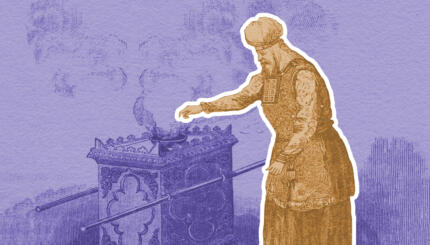Commentary on Parashat Vayakhel, Exodus 35:1-38:20; Numbers 19:1-22
Parashat Vayakhel tells the story of the actual building of the Mishkan [Tabernacle]; before this, we’ve only read the instructions for building it. Upon Moses‘ instructions, the people bring all the materials necessary: skins, wool, special woods, precious metals and stones. Master craftsmen do the specialized tasks.
In Focus
“Moses assembled the entire Israelite community and said to them, ‘These are the words that God has commanded for [you] to do…'” (Exodus 35:1)
Pshat
In the previous three Torah portions, Moses has received from God the instructions for the Mishkan, or portable Sanctuary. Moses now gathers the people together to give them the instructions he has received — the word Vayekhel literally means “gather together.” Moses could not build the Mishkan on his own, but needed the participation of the entire people.
Drash
Rashi makes a cryptic comment on the building of the Mishkan which may raise more questions than it answers: “Moses assembled the entire Israelite community — on the day after Yom Kippur, after he came down the mountain.”
With your help, My Jewish Learning can provide endless opportunities for learning, connection and discovery.
What Rashi seems to be doing here is linking the previous story to the building of the Mishkan. In chapter 34, after the Golden Calf, Moses goes back up the mountain, and asks to see God’s “face.” Instead, he receives a revelation of God’s merciful and forgiving aspects. He then brings two new tablets down the mountain; rabbinic tradition has him returning to the people, with the symbol of God’s forgiveness and a renewed covenant, on the day that would eventually be Yom Kippur.
OK, so far, so good, at least in the world of midrash. Rashi, then, wants to make a midrash that Moses gathered the people immediately (well, the next day) after coming back to them with the new tablets of the covenant. Aside from solving certain rather academic chronological problems, what could Rashi be trying to teach here?
One possibility that occurs to me is that Rashi is subtly comparing building the Mishkan to building a sukkah, the “booth” that many Jews build during the harvest holiday, which begins several days after Yom Kippur. To show that the “work” of religious observance and spirituality never ceases, even after a peak experience like Yom Kippur, many people symbolically begin to build their sukkah right after breaking their Yom Kippur fast — maybe they just put in a nail or two, but they want to demonstrate that spirituality doesn’t stop, even for a day.
Another possibility is raised by the Hasidic teacher R. Moshe of Kobrin:
Moses wanted to hint to the Israelites that not only on Yom Kippur must people be filled with remorse and contrition, love of one’s fellow-person, and friendship, but also on the day after Yom Kippur one must continue in the same fashion. (Source: Itturei Torah)
A third possibility is that this midrash isn’t about the people’s experience, but Moses’. It was Moses who had the “peak experience” (literally, up on a mountaintop!) in our story and it may have been Moses himself who needed to channel his revitalized spiritual energy into a constructive project.
How many times have you or somebody you know gotten a tremendous boost from a conference or a lecture or a religious service, and then just let that energy dissipate without being utilized for constructive purposes? People often get excited at new beginnings, but then the excitement fades once it becomes a daily discipline.
OK, now it’s YOUR turn: what do YOU think Rashi meant to teach by connecting “gathering the people” with the day after Yom Kippur?
Provided by KOLEL–The Adult Centre for Liberal Jewish Learning, which is affiliated with Canada’s Reform movement.
Hasidic
Pronounced: khah-SID-ik, Origin: Hebrew, a stream within ultra-Orthodox Judaism that grew out of an 18th-century mystical revival movement.
Moshe
Pronounced: moe-SHEH, Origin: Hebrew, Moses, whom God chooses to lead the Jews out of Egypt.
sukkah
Pronounced: SOO-kah (oo as in book) or sue-KAH, Origin: Hebrew, the temporary hut built during the Harvest holiday of Sukkot.
Torah
Pronunced: TORE-uh, Origin: Hebrew, the Five Books of Moses.
Yom Kippur
Pronounced: yohm KIPP-er, also yohm kee-PORE, Origin: Hebrew, The Day of Atonement, the holiest day on the Jewish calendar and, with Rosh Hashanah, one of the High Holidays.



